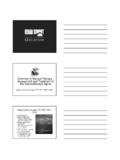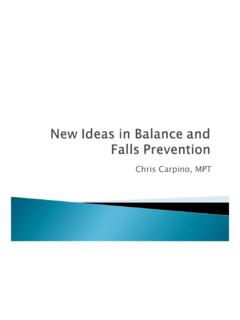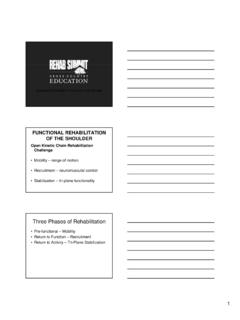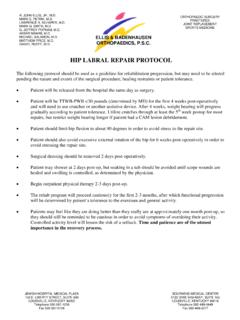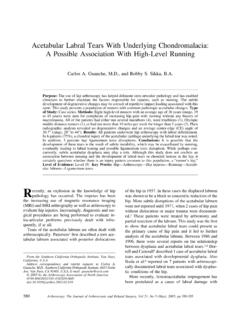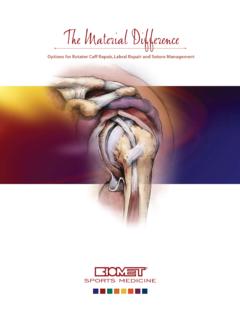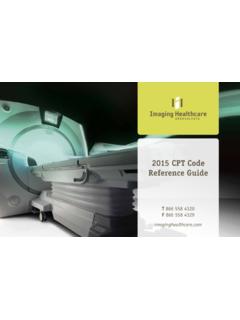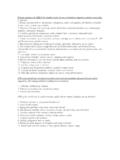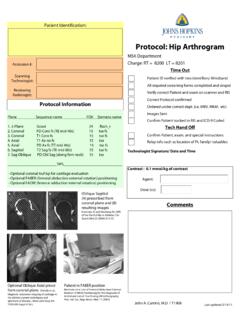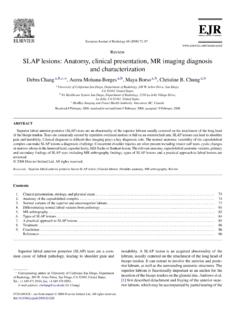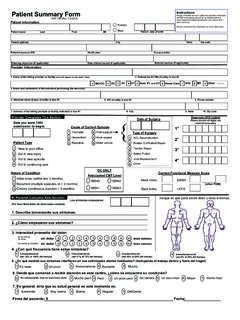Transcription of The Resisted Supination External Rotation Test
1 The Resisted Supination External Rotation Test A New Test for the Diagnosis of Superior labral Anterior Posterior Lesions Thomas H. Myers,* MD, Jason R. Zemanovic, MD, and James R. Andrews, MD.. From the Atlanta Sports Medicine and Orthopaedic Center, Atlanta, Georgia, and the . American Sports Medicine Institute, Birmingham, Alabama Purpose: To evaluate a new clinical test, the Resisted Supination External Rotation test, for the diagnosis of superior labral ante- rior posterior lesions of the shoulder. Study Design: Cohort study (diagnosis); Level of evidence, 2. Methods: Forty athletes (average age, years) with activity-related shoulder pain were enrolled in the study.
2 The patients underwent 3 different tests designed specifically to detect superior labral anterior posterior lesions (the Resisted Supination exter- nal Rotation test, the crank test, and the active compression test); the tests were performed in a random order on the affected shoulder. The results of the tests were compared with arthroscopic findings. Results: Out of 40 athletes, 29 ( ) had superior labral anterior posterior tears. The Resisted Supination External Rotation test had the highest sensitivity ( ), specificity ( ), positive predictive value ( ), negative predictive value ( ), and diagnostic accuracy ( ) of all tests performed.
3 Conclusion: By re-creating the peel-back mechanism, the Resisted Supination External Rotation test is more accurate than 2. other commonly used physical examination tests designed to diagnose superior labral anterior posterior tears in overhead- throwing athletes. By using this test in the context of a thorough clinical history and physical examination, lesions of the supe- rior labrum can be more reliably diagnosed. Keywords: superior labral anterior posterior (SLAP) lesion; superior labral anterior posterior (SLAP) test; physical examination;. peel-back mechanism; superior labrum; overhead-throwing athletes Injury to the biceps superior labral complex in athletes Since the first description of SLAP tears, numerous clin- was first described by Andrews et al2 in 1985.
4 In their ical examinations and provocative maneuvers have been review of 73 overhead-throwing athletes, most injuries to described to aid in the preoperative diagnosis of superior the biceps anchor were seen as detachments of the antero- labral ,10-12,16,19,26 Despite initial reports of high superior labrum from the glenoid. In a later study, Snyder diagnostic reliability, follow-up studies on some of these et al 24 categorized these superior labral anterior posterior maneuvers have failed to reproduce the diagnostic sensi- (SLAP) lesions into 4 discrete types. A type I SLAP lesion tivity and specificity of the original ,14,25 The lack involved degenerative fraying of the superior labrum, of a reliable test for SLAP tears therefore makes preoper- whereas types II to IV described abnormal detachment of ative diagnosis difficult.
5 The biceps anchor, bucket-handle tear of the superior A new diagnostic test for lesions of the superior labrum labrum, and vertical superior labral tear extending into was developed at the institution of the senior author the biceps tendon, ( ). Named the Resisted Supination External Rotation ( Supination /ER) test, this examination attempts to re-create *Address correspondence to Thomas H. Myers, MD, Atlanta Sports the peel-back mechanism of the superior labrum, Medicine and Orthopaedic Center, 3200 Downwood Circle, Suite 500, thought to be a cause of unstable SLAP We hypoth- Atlanta, GA 30327 (email: esized that this test would have higher sensitivity, speci- No potential conflict of interest declared.)
6 Ficity, and diagnostic accuracy for the evaluation of unsta- The American Journal of Sports Medicine, Vol. 33, No. 9 ble superior labral injuries than currently accepted diag- DOI: nostic examinations. 2005 American Orthopaedic Society for Sports Medicine 1315. 1316 Myers et al The American Journal of Sports Medicine MATERIALS AND METHODS Active Compression Test A prospective study of 40 athletes with activity-related The patient stood with the affected arm flexed forward 90 . shoulder pain was performed at our institutions. The and adducted 10 to 15 across the body, with the thumb study group was composed of 39 men and 1 woman, with pointing down.
7 He or she was then instructed to resist an average age of years (range, 17-50 years). Patients downward pressure on the arm by the examiner. Any pain older than 50 years, those with shoulder pain that was not elicited by this maneuver was noted. The patient then the result of athletic injury, and those who did not under- supinated his or her forearm until the palm of the hand go arthroscopic evaluation were excluded from the study. faced up, and the test was repeated. The test was considered The majority of the patients were baseball players (34), positive if the initial pain was alleviated or eliminated in with the remainder participating in football (4), volleyball the palm-up position.
8 Only pain described as deep in the (1), and skiing (1). There were 4 recreational athletes, 7 shoulder was regarded as positive for SLAP tear. All other high school athletes, 16 collegiate athletes, and 13 profes- pain (posterior shoulder, over the acromioclavicular joint). sionals. The dominant arm was affected in 38 patients was considered a negative test. (95%). All patients had failed a course of nonoperative treatment, including physical therapy, cessation of aggra- Crank Test vating activities, and anti-inflammatory medications, before surgical intervention. The patient was placed in a supine or seated position with The patients enrolled in the study were observed by the the affected arm elevated 160 in the scapular plane.
9 An senior author and 1 of 12 orthopaedic sports medicine fel- axial load was applied to the glenohumeral joint as the lows. A thorough clinical history and physical examination humerus was internally and externally rotated. The test were performed by the orthopaedic fellow. When clinical was considered positive if the patient noted (1) pain with history was consistent with activity-related shoulder pain or without a mechanical click or (2) reproduction of the in an athlete, the orthopaedic sports medicine fellow per- patient's activity-related symptoms (usually pain or catch- formed 3 provocative tests specifically for the detection of ing).
10 SLAP lesions: the active compression test,19 the crank test,12 and the Supination /ER test, in addition to other Resisted Supination External Rotation Test physical examination maneuvers appropriate for over- head-throwing athletes. As part of the randomization, each The patient was placed in the supine position on the exam- fellow used a worksheet that listed 8 SLAP-specific tests ination table with the scapula near the edge of the table. in random order. The first 6 tests were performed on each The examiner stood at the patient's side, supporting the patient at the end of the physical examination process affected arm at the elbow and hand.
